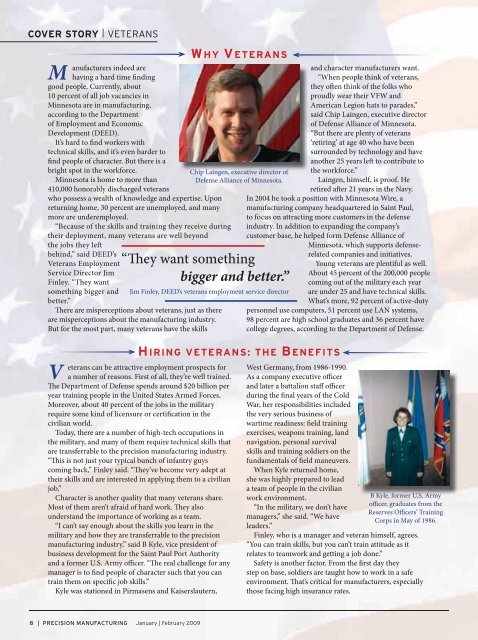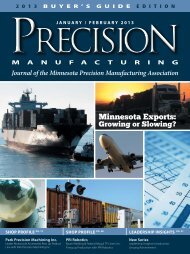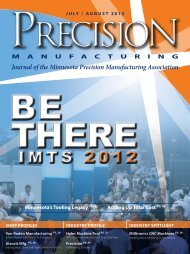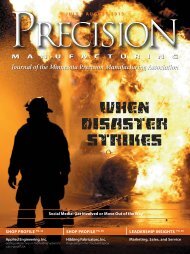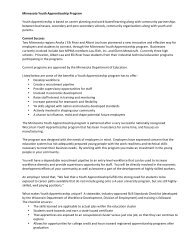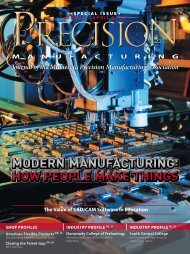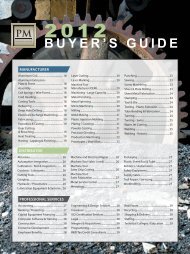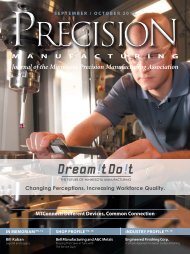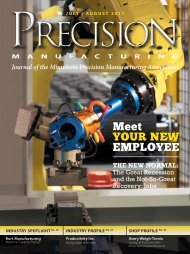January / February - Minnesota Precision Manufacturing Association
January / February - Minnesota Precision Manufacturing Association
January / February - Minnesota Precision Manufacturing Association
- No tags were found...
You also want an ePaper? Increase the reach of your titles
YUMPU automatically turns print PDFs into web optimized ePapers that Google loves.
COVER STORY | VETERANSMVanufacturers indeed arehaving a hard time findinggood people. Currently, about10 percent of all job vacancies in<strong>Minnesota</strong> are in manufacturing,according to the Departmentof Employment and EconomicDevelopment (DEED).It’s hard to find workers withtechnical skills, and it’s even harder tofind people of character. But there is abright spot in the workforce.<strong>Minnesota</strong> is home to more than410,000 honorably discharged veteranswho possess a wealth of knowledge and expertise. Uponreturning home, 30 percent are unemployed, and manymore are underemployed.“Because of the skills and training they receive duringtheir deployment, many veterans are well beyondthe jobs they leftbehind,” said DEED’sVeterans EmploymentService Director JimFinley. “They wantsomething bigger andbetter.”There are misperceptions about veterans, just as thereare misperceptions about the manufacturing industry.But for the most part, many veterans have the skillsH IRING VETERANS: THE B ENEFITSeterans can be attractive employment prospects fora number of reasons. First of all, they’re well trained.The Department of Defense spends around $20 billion peryear training people in the United States Armed Forces.Moreover, about 40 percent of the jobs in the militaryrequire some kind of licensure or certification in thecivilian world.Today, there are a number of high-tech occupations inthe military, and many of them require technical skills thatare transferrable to the precision manufacturing industry.“This is not just your typical bunch of infantry guyscoming back,” Finley said. “They’ve become very adept attheir skills and are interested in applying them to a civilianjob.”Character is another quality that many veterans share.Most of them aren’t afraid of hard work. They alsounderstand the importance of working as a team.“I can’t say enough about the skills you learn in themilitary and how they are transferrable to the precisionmanufacturing industry,” said B Kyle, vice president ofbusiness development for the Saint Paul Port Authorityand a former U.S. Army officer. “The real challenge for anymanager is to find people of character such that you cantrain them on specific job skills.”Kyle was stationed in Pirmasens and Kaiserslautern,W HY V ETERANSChip Laingen, executive director ofDefense Alliance of <strong>Minnesota</strong>.“They want somethingbigger and better.”Jim Finley, DEED’s veterans employment service directorand character manufacturers want.“When people think of veterans,they often think of the folks whoproudly wear their VFW andAmerican Legion hats to parades,”said Chip Laingen, executive directorof Defense Alliance of <strong>Minnesota</strong>.“But there are plenty of veterans‘retiring’ at age 40 who have beensurrounded by technology and haveanother 25 years left to contribute tothe workforce.”Laingen, himself, is proof. Heretired after 21 years in the Navy.In 2004 he took a position with <strong>Minnesota</strong> Wire, amanufacturing company headquartered in Saint Paul,to focus on attracting more customers in the defenseindustry. In addition to expanding the company’scustomer base, he helped form Defense Alliance of<strong>Minnesota</strong>, which supports defenserelatedcompanies and initiatives.Young veterans are plentiful as well.About 45 percent of the 200,000 peoplecoming out of the military each yearare under 25 and have technical skills.What’s more, 92 percent of active-dutypersonnel use computers, 51 percent use LAN systems,98 percent are high school graduates and 36 percent havecollege degrees, according to the Department of Defense.West Germany, from 1986-1990.As a company executive officerand later a battalion staff officerduring the final years of the ColdWar, her responsibilities includedthe very serious business ofwartime readiness: field trainingexercises, weapons training, landnavigation, personal survivalskills and training soldiers on thefundamentals of field maneuvers.When Kyle returned home,she was highly prepared to leada team of people in the civilianwork environment.B Kyle, former U.S. Armyofficer, graduates from the“In the military, we don’t haveReserves Officers’ Trainingmanagers,” she said. “We haveCorps in May of 1986.leaders.”Finley, who is a manager and veteran himself, agrees.“You can train skills, but you can’t train attitude as itrelates to teamwork and getting a job done.”Safety is another factor. From the first day theystep on base, soldiers are taught how to work in a safeenvironment. That’s critical for manufacturers, especiallythose facing high insurance rates.8 | PRECISION MANUFACTURING <strong>January</strong> | <strong>February</strong> 2009


